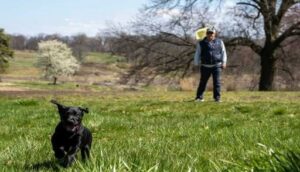Starting at Merion Golf Club, the past and future U.S. Open site and the most historic and famous of all Philadelphia-area golf clubs, it wouldn’t take you long to find another site of Philly golf history. But it might take your imagination.
In fact, you could take a short walk from Merion’s 12th green, board a train and take a 12-minute trip along the Cobbs Creek, under City Avenue, the border between the suburbs and the city, to the site of the waterway’s namesake golf course.
As for your imagination? You might need that because Cobbs Creek Golf Course doesn’t look like much of a golf course these days.
You can see the clearings of trees, the outlines of greens and fairways, the elevated tees. One flag stick even remains standing on a clover-covered green that used to sit adjacent to the clubhouse. Now? Just an old house and a temporary construction office remain.
To the untrained eye, it would be easy to mistake the 340-acre sprawling property for a lightly maintained park. Yet it’s here in the shadow of the Philadelphia skyline, a city in which he has only teed it up competitively a handful of times, that Tiger Woods is building just the second TGR Learning Lab and expanding his TGR Foundation’s reach.
‘Philadelphia School’
In Philadelphia, the private clubs rule. Blue-blood elite private clubs like major championship hosts Merion, Aronomink, Philadelphia Country Club and Philadelphia Cricket Club dot the surrounding suburbs. Even 1958 PGA Championship host Llanarch sits less than three miles away from Cobbs Creek.
But championship-level public courses? Those are few and far between. That’s what made Cobbs an outlier.
Officially, Hugh Wilson, designer of Merion’s fabled East Course, is credited with the design of Cobbs Creek’s Olde Course, which opened for play in 1916. But really, all six of the legendary “Philadelphia School” of golf course architecture — A.W. Tillinghast, George C. Thomas, Jr., William Flynn, George Crump, and William Fownes — contributed to the layout.
When it opened, it was one of the few courses that welcomed all comers, regardless of background or gender. And the course peaked in the 1950s when, for two years, it hosted the PGA Tour’s Philadelphia Daily News Open. Sifford and some of the area’s other top black golfers were even able to play in those events, despite the Tour’s existing Caucasians-only clause.
But then, as Cobbs Creek Foundation Chief Operating Officer Enrique Hervada explained, the course fell from glory.
“They had a Tour event here and then after that it sort of went into a slow decline, like a lot of municipal golf courses that are this old,” Hervada said. “The city owned it. It was run by different management companies over the years. Some would put money into it, most wouldn’t put any money into it. They never took down any trees and never did the basic maintenance that you need to do to maintain a golf course.”
People who played the golf course from the 80s up until recent times could tell it had “good bones” but the conditioning wasn’t there.
“You could barely get a tee in the ground,” Hervada said.
Read more here at golf.com.
